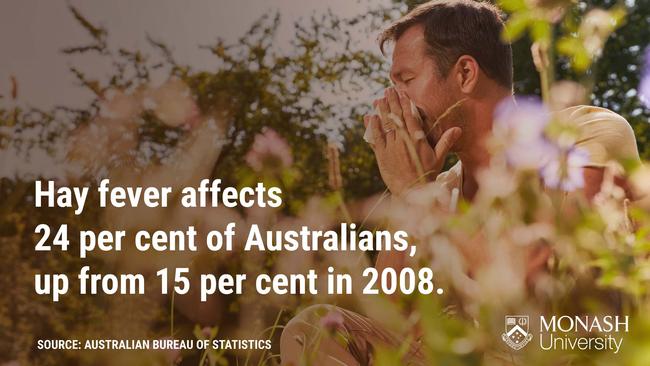Hay fever springs sooner as Australia heats up
Hay fever sufferers are facing a longer and more intense allergy season due to climate change.

HyperLocal
Don't miss out on the headlines from HyperLocal. Followed categories will be added to My News.
You're not imagining it – the hay fever season is getting longer and more intense.
Allergic rhinitis, commonly known as hay fever, affects around one in four Australians.
It occurs when allergens like pollen, dust, or mould come into contact with the body, triggering an allergic reaction.
Those of us who experience hay fever are well-acquainted with the symptoms which can range from sneezing and a runny or blocked nose, to itchy eyes, mouth, skin and fatigue.
While hay fever can catch us off guard year round, it's the spring season that usually has us reaching for the Claratyne.
During this time, days become longer and warmer, causing plants to bloom and release their pollen.
However, this typical cycle is starting to change with human-induced climate change bringing warmer weather and shaking up the seasons.
We only need to look at our own backyards here in the north to see these changes.
For example, the average October day is now around 1.7C warmer than in the early 1970s.
Much like a tiny speck of pollen, these small changes can trigger a significant response.

The blooming trouble with seasonal allergies
Professor Simon Haberle, a leading expert in palynology and aerobiology at the Australian National University, said that climate change is creating longer hay fever seasons.
"When we have warmer climates, we see the seasons being longer and in some cases more intense," he said.
Research shows that spring now tends to begin earlier and summer extends much longer than it did 100 years ago.

Additionally, "experiments overseas have shown that some grasses and other allergenic species under higher carbon dioxide concentrations tend to produce more pollen," Haberle explained.
This combination of more warm days throughout the year and higher levels of carbon dioxide in the atmosphere means our plants can grow faster, flower sooner, and produce more sneeze-inducing pollen.
And an increase in dry and windy days is helping move these allergens to the eyes and noses of Aussie communities.
A breath of fresh air
Nobody likes having a runny nose, teary eyes and sneezing fits, but there are steps we can take to manage these symptoms.
Apps like AirRater and Canberra Pollen are designed to help track daily allergen levels when high pollen counts are forecast.
During these periods, limiting outdoor activities or wearing a mask can help ward off a runny nose.
"We can also reduce the number of allergenic plants in urban areas and focus on planting native species that produce less pollen," Haberle said.
With smart landscape planning by both councils and individuals to select allergy-friendly trees and plants "we can minimise impacts in local communities," Haberle noted.
Alongside managing pesky pollen, we can also limit the impact on our changing climate by reducing emissions.
Making the switch to wind and solar energy can save pennies, and help allergy sufferers breathe easy.
Want more information on how your climate is changing? Check out the last article in this series.
Mandeep Singh is a Senior Project Officer at the Monash Climate Change Communication Research Hub.
This column is part of a collaboration between Monash University and News Corp to deliver hyperlocal weather and climate information.

